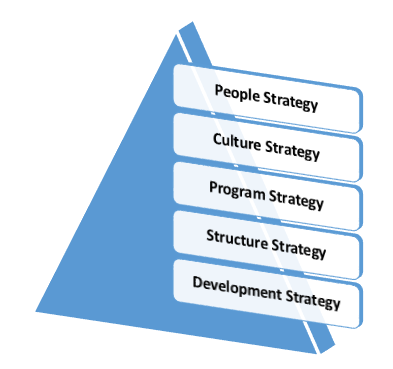Human Resources Management Strategies– The word ‘strategy’, deriving from the Greek noun strategus, meaning ‘commander in chief’. The development and usage of the word suggest that it is composed of Stratos (army) and again (to lead). In the management of the organization, it refers to decisions and actions by the top management of the organization to achieve performance goals.
HR strategies are the science and art for management of people hence, it involves managing the company’s people for their basic and extended needs, working on the cultural differences and developing suitable environment for same, nourishing a motivating and learning culture across the organization and managing the career path of employees by their training and assessment.
Different types of strategies are developed under HRM for managing the human resources and usually, it involves the following:
People Strategy
It is about identifying the type of people and lays emphasis on the personality of the individual but also, on their working styles as well.
Culture Strategy
It is about the culture of the organization and enlisting the leadership and management style prevalent in the organization, which could be pen-door or dictatorial.
Program Strategy
It encompasses developing programs to attract talented and suitable people for the positions in the organization by developing needed remuneration and benefits along with performance-related incentives if needed.
Structure Strategy
It refers to the organizational structure and hierarchy for business-related information and decision flow.
Development Strategy
This strategy comprises of formulating career paths for positions in the organization and developing a suitable environment for the candidate to be trained for identifying and motivating talented people.
Practice Questions
Q1. Which of the following is not a component of performance evaluation?
a) Goal setting
b) Employee feedback
c) Employee discipline
d) Performance appraisal
Correct Answer: c) Employee discipline
Q2. Which of the following is not a benefit of a diverse workforce?
a) Increased creativity
b) Increased innovation
c) Decreased conflict
d) Decreased productivity
Correct Answer: d) Decreased productivity
Q3. Which of the following is a reason for employee turnover?
a) Low job satisfaction
b) High salary
c) Good working conditions
d) Job security
Correct Answer: a) Low job satisfaction
Q4. Which of the following is a type of employee compensation?
a) Benefits
b) Employee discipline
c) Employee feedback
d) None of the above
Correct Answer: a) Benefits
Q5. Which of the following is not a step in the disciplinary process?
a) Verbal warning
b) Written warning
c) Termination
d) Promotion
Correct Answer: d) Promotion




